Gartner Magic Quadrants 2012 (Public facing Approved PPT Slides) 8.8.12
先进制造技术论文(数字化工厂)
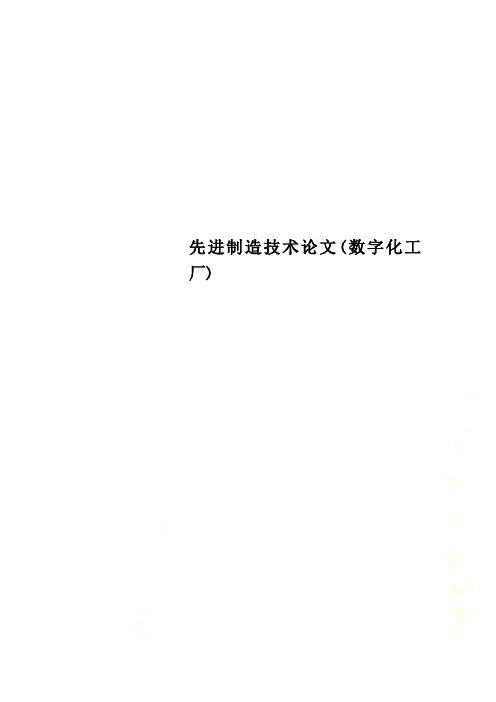
先进制造技术论文(数字化工厂)数字化工厂发展现状及趋势摘要:目前,将数字与智能制造作为关键技术应用到数字化工厂,是现代工业化与信息化融合的应用体现,也是实现智能化制造的必经之路。
打造数字化工厂,是当前工业企业变革、突破的重要手段。
本文对数字化工厂发展现状及趋势进行了初步的研究,通过具体实例,分析了数字化工厂的特点,应用现状并展望了数字化工厂的发展趋势及其决定性意义。
发展数字化工厂对制造企业提升生产力,实现生产智能化和有效管理,推广数字化工厂的建设和发展,搭建智能制造技术和数字化工厂相结合的交流平台,为我国传统产业转型升级、工业与信息化深度融合的战略发展要求,都有着关键性的意义。
关键词:数字化工厂;虚拟仿真;数字制造;智能管理;产业转型升级一、引言现代工业经历了机械化、电气化革命,未来的第三次工业革命必然以机、电、信息相结合的智能化制造革命。
《经济学人》2012年4月发表的《第三次工业革命:制造业与创新》专题报告中阐述了目前由技术创新引发的制造业深刻变化,其中,数字化与智能化的制造技术是“第三次工业革命的核心技术”。
作为数字化与智能化制造的关键技术之一,数字化工厂是现代工业化与信息化融合的应用体现,也是实现智能化制造的必经之路。
数字化工厂借助于信息化和数字化技术,通过集成、仿真、分析、控制等手段,可为制造工厂的生产全过程提供全面管控的一种整体解决方案。
早在2000 年前后,上汽、海尔、华为和成飞等制造企业均已开始着手建立自己的数字化工厂。
今年来,随着国际竞争的不断加剧和我国制造业劳动力成本的不断上升,对设备效率、制造成本、产品质量等环节的要求不断提高,离散制造业中以汽车、工程机械、航空航天、造船为代表的大型企业已越来越重视数字化工厂的建设。
二、数字化工厂的研究热点根据在范围、阶段、视角上的关注点存在差异,对于数字化工厂也有不同提法,比如可视化工厂(Visual Factory)、智慧工厂(Smart Factory)、智能工厂图1典型数字化工厂提法的主要业务范围(Intelligence Factory)、数字化制造(Digital Manufacturing)、虚拟工厂(Virtual Factory)等。
供应商评价与选择
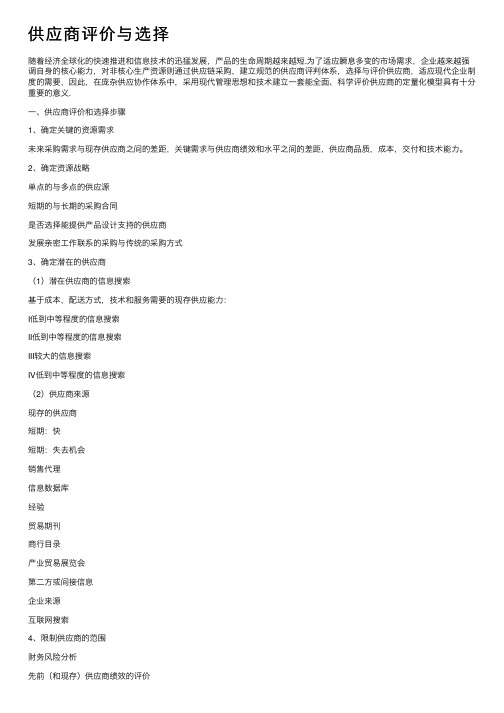
供应商评价与选择随着经济全球化的快速推进和信息技术的迅猛发展,产品的⽣命周期越来越短.为了适应瞬息多变的市场需求,企业越来越强调⾃⾝的核⼼能⼒,对⾮核⼼⽣产资源则通过供应链采购,建⽴规范的供应商评判体系,选择与评价供应商,适应现代企业制度的需要,因此,在庞杂供应协作体系中,采⽤现代管理思想和技术建⽴⼀套能全⾯、科学评价供应商的定量化模型具有⼗分重要的意义.⼀、供应商评价和选择步骤1、确定关键的资源需求未来采购需求与现存供应商之间的差距,关键需求与供应商绩效和⽔平之间的差距,供应商品质,成本,交付和技术能⼒。
2、确定资源战略单点的与多点的供应源短期的与长期的采购合同是否选择能提供产品设计⽀持的供应商发展亲密⼯作联系的采购与传统的采购⽅式3、确定潜在的供应商(1)潜在供应商的信息搜索基于成本,配送⽅式,技术和服务需要的现存供应能⼒:I低到中等程度的信息搜索II低到中等程度的信息搜索III较⼤的信息搜索IV低到中等程度的信息搜索(2)供应商来源现存的供应商短期:快短期:失去机会销售代理信息数据库经验贸易期刊商⾏⽬录产业贸易展览会第⼆⽅或间接信息企业来源互联⽹搜索4、限制供应商的范围财务风险分析先前(和现存)供应商绩效的评价评价供应商提供的信息5、确定供应商评价和选择的⽅法根据供应商提供的信息评价供应商拜访利⽤最佳供应商外部或第三⽅信息6、选择供应商采购⼈员跨功能⼩组供应商寻找⼩组供应商绩效评审⼩组供应商认证⼩组新产品开发⼩组原材料专项(Commodity)⼩组⼆、供应商评价标准供应商的管理能⼒全体员⼯能⼒成本结构全⾯质量绩效,体系和理念⼯艺和技术能⼒,包括供应商的设计能⼒符合环境规章财务能⼒和稳定性⽣产计划和控制体系,包括供应商的交付能⼒信息体系能⼒(EDI,条码,ERP,CDA/CAM等)供应商资源战略,策略和技术更长期的潜在关系具体:1、供应商的管理能⼒经营管理层如何实⾏长期规划管理层保证全⾯质量以及持续完善吗?管理⼈员的变动率⾼吗?管理层有哪些职业经验?采购⼈员和采购经理的专业经验公司未来⽅向的前景管理⼈员/⼯⼈关系的历史管理⼈员对维持和发展的投资决策管理⼈员对未来竞争挑战的准备,为员⼯的培训和发展机会管理⼈员对战略资源的了解2.全体员⼯能⼒员⼯⽀持和保证及持续完善质量的程度劳动⼒的全⾯技术和能⼒(特别是教育和培训)员⼯和管理⼈员的关系状况劳动⼒的弹性员⼯道德劳动⼒的⼈事变动率员⼯为提⾼供应商的业绩做贡献的机会和意愿3、成本结构直接⼈⼯成本间接⼈⼯成本物料成本制造或⼯业运营成本总的制造费⽤成本4、全⾯质量绩效,体系和理念管理⼈员责任⼼统计⼯序控制缺陷的数量安全培训设备全⾯质量管理质量功能展开5、⼯艺和技术能⼒技术,设计,⽅法和设备⼈⼒资源资⾦设备的规划和战略研究和发展对未来⼯艺和技术发展的重视新产品的开发能⼒图纸6、符合环境规章环境记录的公开危险废弃物管理有毒废弃物管理EPA17种危险物料⽬录ISO14000认证回收物流计划环保产品包装破坏臭氧层的物质危险⽓体排放管理7、财务能⼒和稳定性流动⽐率运营⽐率获利能⼒⽐率负债⽐率供应商的财务风险破产⽽⽆供货源缺乏对⼯⼚和机器设备进⾏投资供应商在资⾦⽅⾯可能会过分依赖买⽅资⾦问题背后:质量,效率,债务,管理…主要财务⽐率流动⽐率流动⽐率=流动资产/流动负债>1.0,但太⾼,管理⽔平低速动⽐率=(现⾦+应收款项)/流动负债>0.8,低:现⾦流动有问题,⾼,资产管理⽔平低运营⽐率存货周转率=销货成本/平均存货⽐较⾏业⽔平。
云计算发展历程大事记

云计算发展历程大事记众所周知,云计算被视为科技界的下一次革命,它将带来工作方式和商业模式的根本性改变。
追根溯源,云计算与并行计算、分布式计算和网格计算不无关系,更是虚拟化、效用计算、SaaS、SOA 等技术混合演进的结果。
那么,几十年来,云计算是怎样一步步演变过来的呢?让我们回顾云计算发展历程中的点滴事件:1959 年6 月,ChristopherStrachey 发表虚拟化论文,虚拟化是今天云计算基础架构的基石。
1961 年,JohnMcCarthy 提出计算力和通过公用事业销售计算机应用的思想。
1962 年,J.C.R.Licklider 提出“星际计算机网络”设想。
1965 年美国电话公司WesternUnion 一位高管提出建立信息公用事业的设想。
1984 年,Sun 公司的联合创始人JohnGage 说出了“网络就是计算机”的名言,用于描述分布式计算技术带来的新世界,今天的云计算正在将这一理念变成现实。
1996 年,网格计算Globus 开源网格平台起步。
1997 年,南加州大学教授RamnathK.Chellappa 提出云计算的第一个学术定义“,认为计算的边界可以不是技术局限,而是经济合理性。
1998 年,VMware(威睿公司)成立并首次引入X86 的虚拟技术。
1999 年,MarcAndreessen 创建LoudCloud,是第一个商业化的IaaS 平台。
1999 年, 公司成立,宣布”软件终结“革命开始。
2000 年,SaaS 兴起。
2004 年,Web2.0 会议举行,Web2.0 成为技术流行词,互联网发展进入新阶段。
2004 年,Google 发布MapReduce 论文。
Hadoop 就是Google 集群系统的一个开源项目总称,主要由HDFS、MapReduce 和Hbase 组成,其中HDFS 是GoogleFileSystem(GFS)的开源实现;MapReduce 是GoogleMapReduce 的开源实现;HBase 是GoogleBigTable 的开源实现。
HPE刀片服务器特点及优势介绍

最佳网络虚拟化
Virtual Connect Enterห้องสมุดไป่ตู้rise Manager*
年度创新奖
VC Flex-10*
年度产品大奖
VC Flex-10*
Gartner Magic Quadrant for Blade Servers, March, 2012, ID Number: G00225510 •VC Flex 10 and VCEM awards- 2010
April 2013 ID Number: G00250031
The Forrester Wave is ed by Forrester Research, Inc. Forrester and Forrester Wave are trademarks of Forrester Research, Inc. The Forrester Wave is a graphical representation of Forrester's call on a market and is plotted using a detailed spreadsheet with exposed scores, weightings, and comments. Forrester does not endorse any vendor, product, or service depicted in the Forrester Wave. Information is based on best available resources. Opinions reflect judgment at the time and are subject to change.
Gartner:2024年重要战略技术趋势

2024年重要战略技术趋势1.与AI合作:AI信任、风险和安全管理(AI TRiSM)2.保障安全:持续威胁暴露面管理(CTEM)3.守护未来:可持续技术4.开发人员驱动的自助服务:平台工程5.加速创造:AI增强开发6.定制化解决方案的进一步定制化:行业云平台7.优化决策:智能应用8.权力与责任:生成式AI全民化9.助力先行者:增强型互联员工队伍10.字节组成的买家:机器客户Gartner 2024年十大战略技术趋势在这个人工智能(AI )技术飞速发展的时代,Gartner 重要战略技术趋势收录的创新技术可以帮助企业机构在创造价值的同时,构建强大能力并保障自身安全。
这些创新技术部分由AI 驱动,其他则旨在帮助企业机构实现高效、安全的运营和增长,适应AI 的发展给客户期望和业务模式带来的新变化。
无论是否已领先一步对这些技术有所涉猎,企业机构都可以利用其构建符合自身及员工需求的基础设施、治理机制和工具,以提高自身的韧性和自主性。
如使用得当,这些技术将为企业机构带来以下优势:Gartner 重要战略技术趋势研究,助力企业在AI 时代优化技术投资•建立信任和信心,安全地使用AI•提高在所处生态系统中运营活动的可持续性•选择适合的技术,满足具体任务、行业和功能的需求•提高效率和生产力,同时减少所需投资或工作量•为内外部利益相关方创造更多价值是否以及何时采用这些技术,取决于企业机构的业务目标和当前的发展水平。
只有实现业务目标,才能真正创造价值。
Gartne预计,未来36个月内,这十项技术趋势(每项趋势可能属于一个或多个类别)将被众多业务和技术决策纳入考量。
是否以及何时采用这些技术,取决于企业机构的业务目标。
构建者崛起保护投资交付价值平台工程AI智能应用行业云平台增强开发AI持续威胁暴露面管理信任、风险和安全管理可持续技术机器客户生成式AI全民化增强型互联员工队伍创造价值,构建强大能力并保障自身安全保护投资保护企业的投资,确保企业能从过去和未来的战略技术决策中持续获益。
2012年最值得关注的10家云计算公司
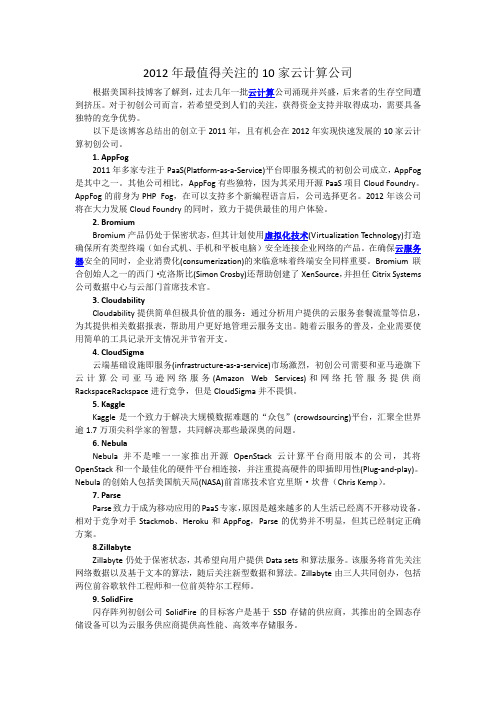
2012年最值得关注的10家云计算公司根据美国科技博客了解到,过去几年一批云计算公司涌现并兴盛,后来者的生存空间遭到挤压。
对于初创公司而言,若希望受到人们的关注,获得资金支持并取得成功,需要具备独特的竞争优势。
以下是该博客总结出的创立于2011年,且有机会在2012年实现快速发展的10家云计算初创公司。
1. AppFog2011年多家专注于PaaS(Platform-as-a-Service)平台即服务模式的初创公司成立,AppFog 是其中之一。
其他公司相比,AppFog有些独特,因为其采用开源PaaS项目Cloud Foundry。
AppFog的前身为PHP Fog,在可以支持多个新编程语言后,公司选择更名。
2012年该公司将在大力发展Cloud Foundry的同时,致力于提供最佳的用户体验。
2. BromiumBromium产品仍处于保密状态,但其计划使用虚拟化技术(Virtualization Technology)打造确保所有类型终端(如台式机、手机和平板电脑)安全连接企业网络的产品。
在确保云服务器安全的同时,企业消费化(consumerization)的来临意味着终端安全同样重要。
Bromium联合创始人之一的西门·克洛斯比(Simon Crosby)还帮助创建了XenSource,并担任Citrix Systems 公司数据中心与云部门首席技术官。
3. CloudabilityCloudability提供简单但极具价值的服务:通过分析用户提供的云服务套餐流量等信息,为其提供相关数据报表,帮助用户更好地管理云服务支出。
随着云服务的普及,企业需要使用简单的工具记录开支情况并节省开支。
4. CloudSigma云端基础设施即服务(infrastructure-as-a-service)市场激烈,初创公司需要和亚马逊旗下云计算公司亚马逊网络服务(Amazon Web Services)和网络托管服务提供商RackspaceRackspace进行竞争,但是CloudSigma并不畏惧。
01-AVAYA公司介绍
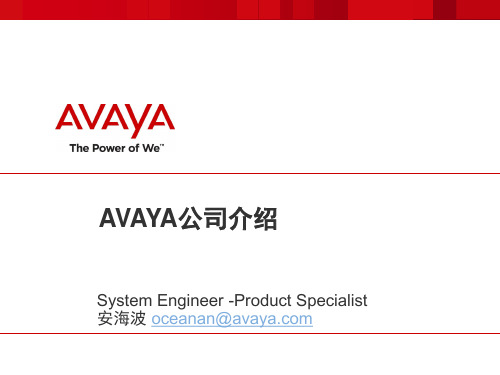
体验
Avaya从“语音” 厂商到 “企业协作”厂商
Avaya – Proprietary. Use pursuant to your signed agreement or Avaya policy.
3
AVAYA公司介绍
作为全球企业通信专家,Avaya致力于提供开放、灵活的通信系统,变革人们的协作方 式,帮助各种不同规模企业提高工作绩效,推动业务成长。
AVAYA公司介绍
System Engineer -Product Specialist 安海波 oceanan@
AVAYA公司发展历程
美国电报电话 公司 1885年成立 1984年拆分 1996年再次 拆分
美国朗讯科技
公司
1996年成立 2000年拆分
Avaya (原朗讯企业网 络部) 2000年成立
Positioned in Leaders Quadrant in Gartner Magic Quadrants for Corporate Telephony, 2010(1); UC, 2010(2) and CC Infrastructure Worldwide, 2010(3) 荣登Gartner 2010年企业语音通信(1)、UC(2) 和全球CC基础设施(3) 魔法象限的领导者象限
Avaya – Proprietary. Use pursuant to your signed agreement or Avaya policy.
5
我们服务的市场
中小企业
中型企业
服 务
大型企业和机构
联络中心 | 数据 | 统一通信
Avaya – Proprietary. Use pursuant to your signed agreement or Avaya policy.
华为创新的未来--任正非答科学家16问---华为2012实验室创立的背后
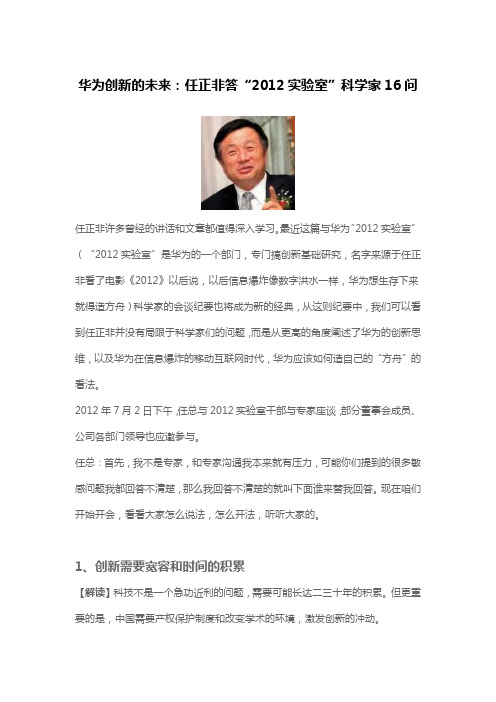
华为创新的未来:任正非答“2012实验室”科学家16问任正非许多曾经的讲话和文章都值得深入学习。
最近这篇与华为“2012实验室”(“2012实验室”是华为的一个部门,专门搞创新基础研究,名字来源于任正非看了电影《2012》以后说,以后信息爆炸像数字洪水一样,华为想生存下来就得造方舟)科学家的会谈纪要也将成为新的经典,从这则纪要中,我们可以看到任正非并没有局限于科学家们的问题,而是从更高的角度阐述了华为的创新思维,以及华为在信息爆炸的移动互联网时代,华为应该如何造自己的“方舟”的看法。
2012年7月2日下午,任总与2012实验室干部与专家座谈,部分董事会成员、公司各部门领导也应邀参与。
任总:首先,我不是专家,和专家沟通我本来就有压力,可能你们提到的很多敏感问题我都回答不清楚,那么我回答不清楚的就叫下面谁来替我回答。
现在咱们开始开会,看看大家怎么说法,怎么开法,听听大家的。
1、创新需要宽容和时间的积累【解读】科技不是一个急功近利的问题,需要可能长达二三十年的积累。
但更重要的是,中国需要产权保护制度和改变学术的环境,激发创新的冲动。
杨强(诺亚方舟实验室主任):我来自诺亚方舟实验室,之前是香港科技大学的教授。
您刚刚讲的一个主题是“创新”,我们都知道,我们中国直到现在还没有产生一个诺贝尔奖,我想从这个角度来看看,咱们华为怎么样来“创新”,想听听您的观点,为什么我们中国直到现在还没有一个诺贝尔奖,产生的必要条件是什么?任总:香港,我认为是藏龙卧虎的地方,香港很多人从欧美留学回来主要就集中在教书了,所以香港的教育质量很好。
我多次跟广东政府讲,要允许香港的学校来内地、广东腹地创办学校,把他们的师资能量释放一下。
我先不讲诺贝尔奖的获得,重要的是怎么能创造对人类的价值。
中国创造不了价值是因为缺少土壤,这个土壤就是产权保护制度。
在硅谷,大家拼命的加班,说不定一夜暴富了。
我有一个好朋友,当年我去美国的时候,他的公司比我们还大,他抱着这个一夜暴富的想法,二十多年也没暴富。
ICT的2012
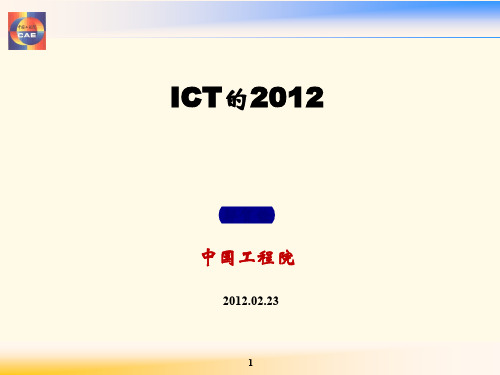
2011年底与2010年同期相比,中国国际干线带宽增加 26.4%,
国内干线带宽年增50%
Source:
10000 1000 100 10 1
Dec,97
Dec,99
Dec,01
Dec,03
10
Dec,05
Dec,07
Dec,09
Dec,11
从节点为中心到内容为中心
网络时代 Web
PaaS-提供一整套基于 PaaS营运支撑平台 Internet的,从开发,测 平台即服务 试,部署,运营到维护 Cache即服务的全方位的集成环境 数据库即服务
弹性计算 DaaS API 云存储 灾备
以软件为中心
数据中心即服务
平台API
网络共享
PC 时代 DOS
弹性软件租用 弹性数据中心 负载均衡
西门子、阿尔卡特、爱立信也相继退出了手机领域,手机终端脱离了
通信产品的范畴成为消费电子产品或计算产品。 Adobe公司禁不住市场的压力,宣布停止Flash移动版本的开发, 转而支持HTML5,这是开放标准的胜利。 NFC及移动支付--到2013年,将有1/5的手机具有NFC设备。
13
云计算--从以计算机为中心到以服务为中心
云计算是一种资源交付和使用模式,通过互联网快速部署资源或获得自助式服务, 按需扩展和使用,按使用量付费。
云计算
软件即 服务
?
资源共享
云计算时代
以用户为中心
SaaS-软件提供者将应 用许可给用户作为按需使 用的一种软件部署模型。
Cloud
以服务为中心
信息共享
8
互联网带宽增长超过了摩尔定律
The maximum and minimum daily traffic volume on the IX backplane in bits per second. YouTube目前占全球视频流量的43.8%,在2012年1月 每分钟有60小时的视频节目上载,该网站每天的视频浏览 量已达40亿次,2011年相当于 地球上每一个人都观赏过该网站 140次视频内容。
Avaya UC简介(BP培训)
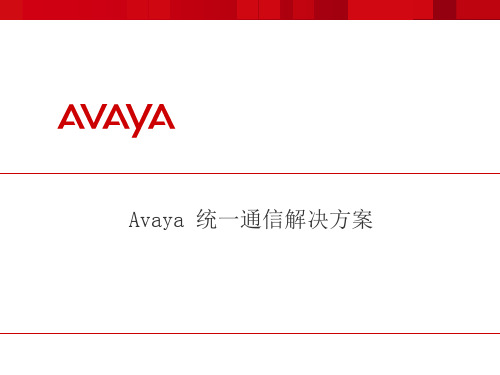
单系统支持10000个座席(数字座席,模拟座席,IP座席)
单系统支持12000条中继(SS7/ ISDN PRI/ FXO / H.323 /SIP) 单系统可提供64条CTI 链路
每小时可处理高达600000次呼叫(BHCC)
中石油海外语音网(6000)
普华永道(6000) DELL中国(5000) 嘉实基金(1000) 中欧国际工商学院(1500) 苏宁电器(12000) 安踏(1400)
为客户提供适应各种规模和需求的解决方案
Avaya 通信应用
AAC全媒体会议 视频协作 Radvision
Power and Associates 2010 Certified Technology Service & Support Program SM, developed in conjunction with Technology Services Industry Associates (TSIA). For more information, visit or
TeleWorker
Power User
Agent
Supervisor
Choose Based on the Number of User Types you Have (One Time Seat License)
GROUP COLLABORATION
Basic Telephony IP Telephony with Mobility Unified Communications UC and Contact Center
最佳知识管理实践
2012年6月全球十大超级计算机排行榜_345709390_93140937

2012全球十大超级计算机全球超级计算机500强排行榜每年发布两次,它评选出了世界上功能最强大的计算机系统。
这些超级计算机有许多不仅仅因强大的处理能力而吸引眼球,还因卓越的设计和外观而吸引眼球。
本文介绍了今年6月份在德国汉堡举行的2012年国际超级计算机大会(ISC)上宣布的全球超级计算机500强排行榜十强。
第一名:红杉(Sequoia)超级计算机,劳伦斯·利弗莫尔国家实验室IBM和加利福尼亚州劳伦斯·利弗莫尔国家实验室的研究人员与红杉合影,劳伦斯·利弗莫尔国家实验室的这个系统被评为全球超级计算机500强排行榜上功能最强大的超级计算机。
荣登全球超级计算机500强榜首的是红杉,这是基于IBM Power架构的蓝色基因/Q超级计算机,位于美国能源部建在加利福尼亚的劳伦斯·利弗莫尔国家实验室。
红杉的出现让美国自2009年11月以来重返全球超级计算机500强榜单的头把交椅。
红杉包含96个机架、98304个计算节点、160万个处理器核心和1.6 PB 内存,按Linpack基准测试显示,运算能力创下了令人叹为观止的新记录:每秒16.32千万亿次浮点运算。
美国国家核安全管理局使用红杉来研究美国核威慑武器的安全性和可靠性,因而不需要进行地下试验。
蓝色基因/ Q红杉其性能是前一代蓝色基因/L技术的八倍。
第二名:K超级计算机,日本理化学研究所高级计算科学研究所(AICS)“K”超级计算机由富士通和理化学研究所中心(RIKEN center)联合开发研制而成,现在是名列亚军的系统。
K计算机安装在日本神户的理化学研究所高级计算科学研究所,按Linpack基准测试显示,它使用705024个SPARC64处理核心,性能达到了惊人的每秒10.51千万亿次浮点运算。
K计算机是率先达到每秒10千万亿次浮点运算这一性能水平的超级计算机。
K计算机曾在2011年6月和2011年11月两次占据榜首。
2012年Gartner全球IT技术峰会汇总

CIO和IT执行首脑会议(CIO & IT Executive Summit) INDIA印度
ห้องสมุดไป่ตู้
待定TBD
基 础 设 施 建 设 , 运 营 及 数据 中心 峰会 (Infrastructure, Operations & 5月 14 – 15 Data Center Summit) APAC 亚太地区 2月 Summit) 商业智能与信息管理峰会(Business Intelligence & Information Management21 – 22 基础设施建设,运营及数据中心峰会(Infrastructure, Operations & Data 3月 5 – Summit) Center 6 7月 16 – 17 安全与风险管理峰会(Security & Risk Management Summit) 7月 23 – 24 供应链的行政会议(Supply Chain Executive Conference) 8月 20 – 21 业务流程管理峰会(Business Process Management Summit) 8月 22 – Summit) 应用架构,开发与集成峰会(Application Architecture, Development & Integration23 JAPAN 3月 2 企业应用高峰论坛(Enterprise Application Summit) IT基础设施和数据中心峰会(IT Infrastructure & Data Center Summit) 4月26 – 27 5月 28 – 29 全球采购高峰论坛(Global Sourcing Summit) 6月 11 – 12 安全与风险管理峰会(Security & Risk Management Summit) 7月 Summit) 商业智能与信息管理峰会(Business Intelligence & Information Management12 – 13
Gartner公司定义2012十大战略技术
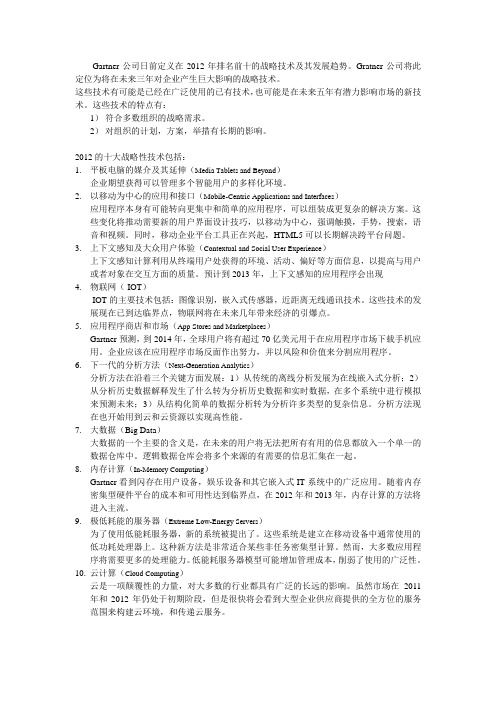
Gartner公司日前定义在2012年排名前十的战略技术及其发展趋势。
Gratner公司将此定位为将在未来三年对企业产生巨大影响的战略技术。
这些技术有可能是已经在广泛使用的已有技术,也可能是在未来五年有潜力影响市场的新技术。
这些技术的特点有:1)符合多数组织的战略需求。
2)对组织的计划,方案,举措有长期的影响。
2012的十大战略性技术包括:1.平板电脑的媒介及其延伸(Media Tablets and Beyond)企业期望获得可以管理多个智能用户的多样化环境。
2.以移动为中心的应用和接口(Mobile-Centric Applications and Interfaces)应用程序本身有可能转向更集中和简单的应用程序,可以组装成更复杂的解决方案。
这些变化将推动需要新的用户界面设计技巧,以移动为中心,强调触摸,手势,搜索,语音和视频。
同时,移动企业平台工具正在兴起,HTML5可以长期解决跨平台问题。
3.上下文感知及大众用户体验(Contextual and Social User Experience)上下文感知计算利用从终端用户处获得的环境、活动、偏好等方面信息,以提高与用户或者对象在交互方面的质量。
预计到2013年,上下文感知的应用程序会出现4.物联网( IOT)IOT的主要技术包括:图像识别,嵌入式传感器,近距离无线通讯技术。
这些技术的发展现在已到达临界点,物联网将在未来几年带来经济的引爆点。
5.应用程序商店和市场(App Stores and Marketplaces)Gartner预测,到2014年,全球用户将有超过70亿美元用于在应用程序市场下载手机应用。
企业应该在应用程序市场反面作出努力,并以风险和价值来分割应用程序。
6.下一代的分析方法(Next-Generation Analytics)分析方法在沿着三个关键方面发展:1)从传统的离线分析发展为在线嵌入式分析;2)从分析历史数据解释发生了什么转为分析历史数据和实时数据,在多个系统中进行模拟来预测未来;3)从结构化简单的数据分析转为分析许多类型的复杂信息。
Gartner魔力象限
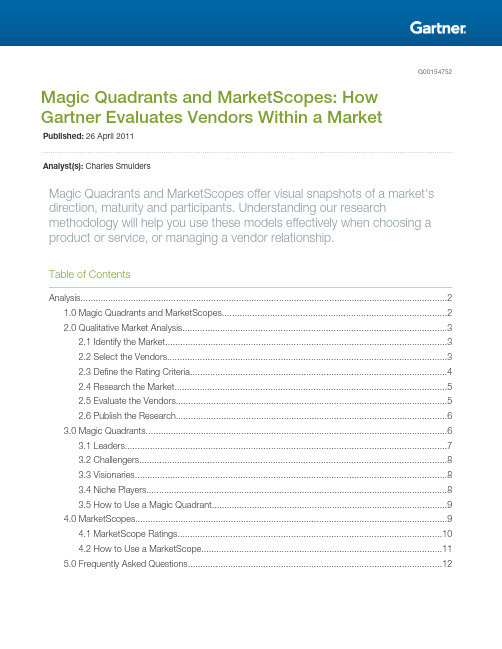
G0******* Magic Quadrants and MarketScopes: How Gartner Evaluates Vendors Within a MarketPublished: 26 April 2011Analyst(s): Charles SmuldersMagic Quadrants and MarketScopes offer visual snapshots of a market's direction, maturity and participants. Understanding our research methodology will help you use these models effectively when choosing a product or service, or managing a vendor relationship.Table of Contents Analysis (2)1.0 Magic Quadrants and MarketScopes (2)2.0 Qualitative Market Analysis (3)2.1 Identify the Market (3)2.2 Select the Vendors (3)2.3 Define the Rating Criteria (4)2.4 Research the Market (5)2.5 Evaluate the Vendors (5)2.6 Publish the Research (6)3.0 Magic Quadrants (6)3.1 Leaders (7)3.2 Challengers (8)3.3 Visionaries (8)3.4 Niche Players (8)3.5 How to Use a Magic Quadrant (9)4.0 MarketScopes (9)4.1 MarketScope Ratings (10)4.2 How to Use a MarketScope (11)5.0 Frequently Asked Questions (12)List of TablesTable 1. MarketScope Rating Framework (11)List of FiguresFigure 1. Market Life Cycle (3)Figure 2. The Magic Quadrant (7)Figure 3. The MarketScope (10)Analysis1.0 Magic Quadrants and MarketScopesAssessing a market and its participants is a daunting task. Vendor differentiation caused by differing sizes, levels of complexity and strategies can inhibit comparisons of vendor offerings, and themarket's overall direction is often murky. Gartner's Magic Quadrants and MarketScopes solve these problems by offering snapshots of markets and their participants, enabling you to map vendorstrengths against your current and future needs.Markets vary in many ways, but all follow a predictable life cycle with these phases: embryonic,emerging, high-growth, consolidating, maturity and declining. A market's current phase helpsdetermine which model we use to assess it:■Magic Quadrants depict markets in the middle phases of their life cycle by using a two-dimensional matrix that evaluates vendors based on their completeness of vision and ability toexecute. The Magic Quadrant has 15 weighted criteria that plot vendors based on their relativestrengths in the market. This model is well suited for high-growth and consolidating marketswhere market and vendor differentiations are distinct.■MarketScopes rate vendors based on criteria that focus on the important aspects of an emerging or mature market. In emerging markets, vendors and products are less well known ortested in the market, and it would be difficult to analyze all criteria typically used in a MagicQuadrant. In mature markets, vendors and products are typically well known, and demand forrelative comparison shifts to a focus on differentiating criteria. By focusing on a limited set ofcriteria for these markets, MarketScopes will help you understand the dynamics of the market,as well as the strengths of its vendors, even when the market is not well suited for MagicQuadrant analysis.For example, we may analyze an emerging market with a MarketScope and use a Magic Quadrantwhen the market enters its high-growth phase. We then may return to a MarketScope as the market matures (see Figure 1).Page 2 of 13Gartner, Inc. | G0*******Figure 1. Market Life CycleMarket SizePhase 13245Source: Gartner (April 2011)2.0 Qualitative Market AnalysisTo evaluate vendors for Magic Quadrants and MarketScopes, Gartner uses a comprehensiveprocess that defines the boundaries of the market, research focus and the steps taken to form the analysis.2.1 Identify the MarketTo be considered for a Magic Quadrant or MarketScope, a market must be distinct and viable. It is selected for analysis based on the impact of emerging trends and users' need to understand changing market dynamics. We focus on markets in which our insights can assist clients with planning, investment decision making and the ongoing support of vendor relationships.2.2 Select the VendorsA Magic Quadrant or MarketScope is not intended to be an exhaustive analysis of every vendor in a market, but rather a focused analysis. Inclusion criteria consist of market share, revenue, number of clients, types of products or services, target market or other defining characteristics that help narrow the scope of the research to those vendors that we consider to be the most important or best suited to our clients' needs.Gartner, Inc. | G0*******Page 3 of 132.3 Define the Rating CriteriaMagic Quadrants use standard criteria in two categories: completeness of vision and ability toexecute. MarketScopes may use up to seven of these criteria to focus on factors that differentiate a particular market. We then adapt the inclusion criteria to a market by prioritizing and weighting them based on a high, low or standard scale of importance. In some cases, a criterion may have a "norating" weight because it has low relevance for the market.2.3.1 Completeness of Vision■Market Understanding: The ability of a vendor to understand buyers' needs and translate these needs into products and services. A vendor that shows the highest degree of visionlistens and understands buyers' wants and needs, which it can shape or enhance with itsvision.■Marketing Strategy: A clear, differentiated set of messages consistently communicated throughout the organization and publicized through the Web site, advertising, customerprograms and positioning statements.■Sales Strategy: A strategy for selling products that uses the appropriate network of direct and indirect sales, marketing, service and communication affiliates to extend the scope and depth ofa vendor's market reach, skills, expertise, technologies, services and customer base.■Offering (Product) Strategy: A vendor's approach to product development and delivery that emphasizes differentiation, functions, methodology and feature set in relation to current andfuture requirements.■Business Model: The validity and logic of a vendor's underlying business proposition.■Vertical/Industry Strategy: A vendor's strategy to direct resources, skills and offerings to meet the needs of market segments, including vertical industries.■Innovation: Marshaling of resources, expertise or capital for competitive advantage, investment, consolidation or defense against acquisition.■Geographic Strategy: A vendor's strategy to direct resources, skills and offerings to meet the needs of regions outside of the vendor's "home" or native area, directly or through partners,channels and subsidiaries, as appropriate for that region and market.2.3.2 Ability to Execute■Product/Service: Core goods and services offered by the vendor that compete in and serve the market. This category includes product and service capabilities, quality, feature sets andskills, offered natively or through original equipment manufacturers, as defined in the marketdefinition and detailed in subcriteria.■Overall Viability: Includes an assessment of the vendor's overall financial health, the financial and practical success of the relevant business unit, and the likelihood of that business unit tocontinue to invest in and offer the product within the vendor's product portfolio.Page 4 of 13Gartner, Inc. | G0*******■Sales Execution/Pricing: The vendor's capabilities in pre-sales activities and the structure that supports them. This criterion includes deal management, pricing and negotiation, pre-salessupport and the overall effectiveness of the sales channel.■Market Responsiveness and Track Record: Ability to respond, change direction, be flexible and achieve competitive success as opportunities develop, competitors act, customer needsevolve and market dynamics change. This criterion also considers the vendor's history ofresponsiveness.■Marketing Execution: The clarity, quality, creativity and efficacy of programs designed to deliver the vendor's message to influence the market, promote its brand and business, increaseawareness of its products and establish a positive identification with the product, brand orvendor with buyers. This "mind share" can be driven by a combination of publicity, promotions,thought leadership, word of mouth and sales activities.■Customer Experience: Relationships, products, and services and programs that enable clients to succeed with the products evaluated. This criterion includes the ways customers receivetechnical support or account support. It can also include ancillary tools, customer supportprograms (and their quality), availability of user groups and service-level agreements.■Operations: The vendor's ability to meet its goals and commitments. Factors include the quality of the organizational structure, such as skills, experiences, programs, systems and othervehicles, that enable the vendor to operate effectively and efficiently.2.4 Research the MarketResearch activities include, but are not limited to:■Vendor briefings■Surveys■Vendor-provided references■Industry contacts■Client interviews■Public sources, such as U.S. Securities and Exchange Commission filings, articles, speeches and published papers■Input from Gartner analysts2.5 Evaluate the VendorsTeams of analysts collaborate to evaluate and score each vendor using the weighted criteria. Theresulting scores are used to generate a Magic Quadrant or MarketScope.Gartner, Inc. | G0*******Page 5 of 132.6 Publish the ResearchThe Magic Quadrant or MarketScope is published as a research document that explains the vendor positions and ratings, as well as new developments in the market, and thus provides a context inwhich to use the models. During this step, the research undergoes rigorous internal peer review and validation, followed by a factual review by the vendors included on the Magic Quadrant orMarketScope.3.0 Magic QuadrantsThe Magic Quadrant figure (see Figure 2) is based on two axes:■Ability to Execute: Summarizes factors such as the vendor's financial viability, market responsiveness, product development, sales channels and customer base.■Completeness of Vision: Reflects the vendor's innovation, whether the vendor drives or follows the market, and if the vendor's view of how the market will develop matches Gartner'sperspective.Page 6 of 13Gartner, Inc. | G0*******Figure 2. The Magic QuadrantAbility toExecuteviability,services,features)Completeness of Vision(in technology, viability, services, features)on VisionariesNiche Players Source: Gartner (April 2011)The vendors positioned in the four quadrants — Leaders, Challengers, Visionaries and Niche Players — share certain characteristics.3.1 LeadersLeaders provide mature offerings that meet market demand, as well as demonstrate the vision necessary to sustain their market position as requirements evolve. The hallmark of leaders is that they focus and invest in their offerings to the point that they lead the market and can affect its Gartner, Inc. | G0*******Page 7 of 13overall direction. As a result, leaders can become the vendors to watch as you try to understandhow new offerings might evolve.Leaders typically possess a large, satisfied customer base (relative to the size of the market) andenjoy high visibility within the market. Their size and financial strength enable them to remain viable in a challenging economy.Leaders typically respond to a wide market audience by supporting broad market requirements.However, they may fail to meet the specific needs of vertical markets or other more-specializedsegments.3.2 ChallengersChallengers have a strong ability to execute but may not have a plan that will maintain a strongvalue proposition for new customers. Larger vendors in mature markets may often be positioned as challengers because they choose to minimize risk or avoid disrupting their customers or their ownactivities.Although challengers typically have significant size and financial resources, they may lack a strongvision, innovation or overall understanding of market needs. In some cases, challengers may offerproducts nearing the end of their lives that dominate a large but shrinking segment.Challengers can become leaders if their vision develops. Large companies may fluctuate betweenthe Challengers and Leaders quadrants as their product cycles and market needs shift.3.3 VisionariesVisionaries align with Gartner's view of how a market will evolve, but they have less-provencapabilities to deliver against that vision. In early markets, this status is normal. In more-maturemarkets, it may reflect a competitive strategy for a smaller vendor — such as selling an innovationahead of mainstream demand — or a larger vendor trying to break out of a rut or differentiate.For vendors and customers, visionaries fall in the higher-risk/higher-reward category. They oftenintroduce new technology, services or business models, and they may need to build financialstrength, service and support, and sales and distribution channels. Whether visionaries becomechallengers or leaders may depend on if companies accept the new technology or if the vendorscan develop partnerships that complement their strengths. Visionaries sometimes are attractiveacquisition targets for leaders or challengers.3.4 Niche PlayersNiche players do well in a segment of a market, or they have a limited ability to innovate oroutperform other vendors. This may be because they focus on a functionality or geographic region,or they are new entrants to the market. Alternatively, they may be struggling to remain relevant in amarket that is moving away from them. Niche players may have reasonably broad functionality butwith limited implementation and support capabilities, and relatively limited customer bases. Theyhave not yet established a strong vision for their offerings.Page 8 of 13Gartner, Inc. | G0*******Assessing niche players is more challenging than assessing vendors in other quadrants becausesome niche players could make progress, while others do not execute well and may not have thevision to keep pace with broader market demands.A niche player may be a perfect fit for your requirements. However, if it goes against the direction ofthe market — even if you like what it offers — then it may be a risky choice because its long-termviability will be threatened.3.5 How to Use a Magic QuadrantYour needs and circumstances should determine how you use the Magic Quadrant, not the otherway around. To evaluate vendors in the Leaders quadrant only and ignore those in other quadrantsis risky and thus discouraged. For example, a vendor in the Niche Players quadrant could offerfunctions that are ideally suited to your needs. Similarly, a leader may not offer functions that meetyour requirements — for example, its offerings may cost more than competitors', or it may notsupport your region or industry. Use a Magic Quadrant to narrow your list of choices, but don't base your decision only on the model. Talk to the Gartner analyst who created the research for moredetails and insight.Vendor positioning in Magic Quadrants illustrates useful information about vendors. For example, ifyou want to make a strategic investment in a technology, then a vendor's viability will be critical.Therefore, weight a vendor's ability to execute more heavily than its completeness of vision, andevaluate challengers before visionaries. Conversely, if you can gain a competitive advantage byinvesting in an emerging technology, then evaluate visionaries before challengers.The overall positioning of vendors in a Magic Quadrant offers a high-level view of the market. In ahighly mature market, a preponderance of vendors may cluster in the Leaders quadrant becausemost vendors will tend to offer a complete set of products and services, with little differentiation. By contrast, in an emerging market, most vendors will cluster in the Niche Players quadrant, and mostofferings will be incomplete yet distinctive.4.0 MarketScopesMarketScopes provide an overall market rating that indicates the strength and potential for themarket in general. This is particularly important in emerging markets, when hype is high and it isdifficult to assess the long-term viability or evolution of offerings. In mature markets, MarketScopes provide insight about the ongoing value of products and services.In addition to the overall market rating, MarketScopes provide ratings for selected vendors basedon market-critical criteria (see Figure 3).Gartner, Inc. | G0*******Page 9 of 13Figure 3. The MarketScopeSource: Gartner (April 2011)4.1 MarketScope RatingsMarketScope ratings and evaluations are limited to a select set of criteria identified in the researchand are not meant to be exhaustive vendor evaluations. The ratings follow Gartner's standard rating format (see Table 1).Page 10 of 13Gartner, Inc. | G0*******Table 1. MarketScope Rating FrameworkSource: Gartner (April 2011)4.2 How to Use a MarketScopeUse a MarketScope to understand — at a high level — the strength and potential of a market and to review vendors in the space. A MarketScope can provide a solid definition of a market, illustrateimportant trends and dynamics that will affect overall market strength, and identify critical criteriathat distinguish vendors in the market.Consider how the criteria used to build the MarketScope map to your priorities. (Remember that aMarketScope uses fewer criteria than a Magic Quadrant.) To illustrate market differentiation, wemay have excluded criteria that are critical to you. For example, in an emerging market, aMarketScope may focus on innovation and market strategy, while your priorities may be financialviability and product functions. In a mature market, a MarketScope might focus on customerexperience and track record, while you need to consider pricing and architectural alignment.Gartner, Inc. | G0*******Page 11 of 13Keep in mind that the list of vendors is representative, not exhaustive. Excluding a vendor from theresearch does not imply that it is not viable or competitive.5.0 Frequently Asked QuestionsCan Magic Quadrants and MarketScopes be used as vendor selection tools? Magic Quadrants and MarketScopes analyze a market and can help you to focus your search on important criteria.However, they will not provide the details needed during the vendor selection process to align yourrequirements to a vendor.Why aren't all vendors from a market included in a Magic Quadrant or MarketScope? In mostcases, it is not possible to cover every vendor in a market — there are too many, or some areirrelevant based on the criteria. Therefore, we focus our research in a way that will provide thegreatest value to Gartner clients. Sales contracts, vendor requests and client engagements do notinitiate or drive inclusion in Magic Quadrant or MarketScope research.What does it mean if a vendor isn't included in a Magic Quadrant or MarketScope? It meansthat they did not meet the inclusion criteria defined for that Magic Quadrant or MarketScope. It does not imply that the vendor is not viable or competitive. It might indicate that the vendor has a slightly different strategy or functional match, or that it addresses a different target market. We publish theinclusion criteria with the Magic Quadrant or MarketScope to help you understand why a vendormight not have been included.Is a market always analyzed the same way? No. As a market matures, it changes and so doesthe analysis. Year to year, the inclusion criteria, weightings and our opinion about what it takes tomaintain market strength may change.Is there a calendar for when Magic Quadrants and MarketScopes will be published? Acalendar of planned Magic Quadrant and MarketScope research is posted on .How often are Magic Quadrants and MarketScopes updated? Magic Quadrants andMarketScopes are updated at least annually and may be updated sooner to respond to marketchanges.How can I compare current Magic Quadrants to previous versions? Previous versions areavailable online as archived files. When performing direct comparisons, understand that the marketdefinition and criteria may have changed, thus affecting vendors' positions or ratings.This is part of two sets of related research. See the following for an overview:■Enterprise Architecture Research Index: Enterprise Technology Architecture■IT Challenges for Enterprises in China, 2012Page 12 of 13Gartner, Inc. | G0*******Regional HeadquartersCorporate Headquarters56 Top Gallant RoadStamford, CT 06902-7700USA+1 203 964 0096Japan Headquarters Gartner Japan Ltd.Atago Green Hills MORI Tower 5F 2-5-1 Atago, Minato-ku Tokyo 105-6205JAPAN+ 81 3 6430 1800European Headquarters Tamesis The Glanty Egham Surrey, TW20 9AW UNITED KINGDOM +44 1784 431611Latin America HeadquartersGartner do BrazilAv. das Nações Unidas, 125519° andar—World Trade Center04578-903—São Paulo SPBRAZIL+55 11 3443 1509Asia/Pacific HeadquartersGartner Australasia Pty. Ltd.Level 9, 141 Walker StreetNorth SydneyNew South Wales 2060AUSTRALIA+61 2 9459 4600© 2011 Gartner, Inc. and/or its affiliates. All rights reserved. Gartner is a registered trademark of Gartner, Inc. or its affiliates. Thispublication may not be reproduced or distributed in any form without Gartner’s prior written permission. The information contained in this publication has been obtained from sources believed to be reliable. Gartner disclaims all warranties as to the accuracy, completeness or adequacy of such information and shall have no liability for errors, omissions or inadequacies in such information. This publicationconsists of the opinions of Gartner’s research organization and should not be construed as statements of fact. The opinions expressed herein are subject to change without notice. Although Gartner research may include a discussion of related legal issues, Gartner does not provide legal advice or services and its research should not be construed or used as such. Gartner is a public company, and its shareholders may include firms and funds that have financial interests in entities covered in Gartner research. Gartner’s Board ofDirectors may include senior managers of these firms or funds. Gartner research is produced independently by its research organization without input or influence from these firms, funds or their managers. For further information on the independence and integrity of Gartner research, see “Guiding Principles on Independence and Objectivity” on its website, /technology/about/ombudsman/omb_guide2.jsp.Gartner, Inc. | G0*******Page 13 of 13。
MSFT Strategy
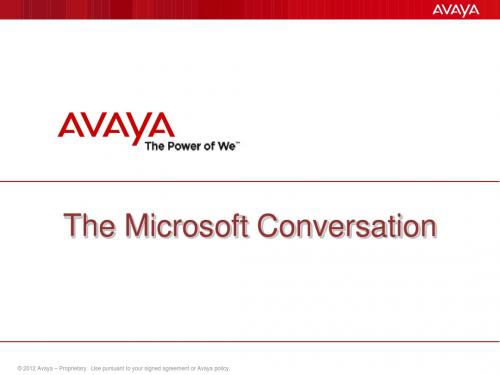
© 2012 Avaya – Proprietary. Use pursuant to your signed agreement or Avaya policy.
3
Learning Objectives
• Prepare for the Lync conversation
– Lync is moving up the Hype Cycle
9
© 2012 Avaya – Proprietary. Use pursuant to your signed agreement or Avaya policy.
10
Assess & Address the MS Threat –
Be prepared; avoid nasty surprises
© 2012 Avaya – Proprietary. Use pursuant to your signed agreement or Avaya policy.
12
The Power Base: Consumerization of IT (2010 – 2012)
© 2012 Avaya – Proprietary. Use pursuant to your signed agreement or Avaya policy.
IM, email, presence, voice, video, and application sharing” This graphic was published by Gartner, Inc. as part of a larger
research document and should be evaluated in the context of the entire document. The Gartner document is available upon request from Avaya. Gartner does not endorse any vendor, product or service depicted in its research publications, and does not advise technology users to select only those vendors with the highest ratings. Gartner research publications consist of the opinions of Gartner’s research organization and should not be construed as statements of fact. Gartner disclaims all warranties, expressed “Unify allwith your voice, video, data, and any warranties or implied, respect to this research, including mobile applicationsor for interactive of merchantability fitness for a particular purpose.
Gartner 和魔力象限
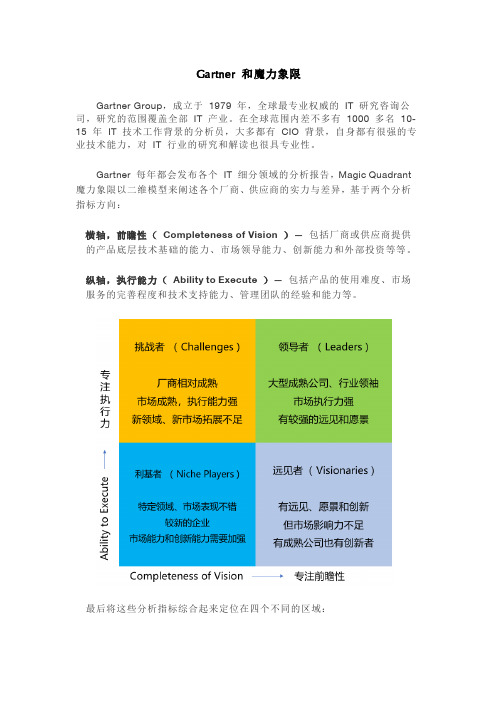
Gartner 和魔力象限Gartner Group,成立于1979 年,全球最专业权威的IT 研究咨询公司,研究的范围覆盖全部IT 产业。
在全球范围内差不多有1000 多名10-15 年IT 技术工作背景的分析员,大多都有CIO 背景,自身都有很强的专业技术能力,对IT 行业的研究和解读也很具专业性。
Gartner 每年都会发布各个IT 细分领域的分析报告,Magic Quadrant 魔力象限以二维模型来阐述各个厂商、供应商的实力与差异,基于两个分析指标方向:横轴,前瞻性(Completeness of Vision )— 包括厂商或供应商提供的产品底层技术基础的能力、市场领导能力、创新能力和外部投资等等。
纵轴,执行能力(Ability to Execute )— 包括产品的使用难度、市场服务的完善程度和技术支持能力、管理团队的经验和能力等。
最后将这些分析指标综合起来定位在四个不同的区域:Niche Players 利基者,特定领域者象限执行力和前瞻性都不足,但是可能在特定的某个市场做的不错,同时也不会超过那些特别大型的成熟厂商或者供应商。
通常是集中在某些特定领域、专业领域,或者是一些比较新的企业。
Challengers 挑战者象限执行力很强,但是前瞻性不足。
通常情况下是指比较大型的成熟厂商,由于其本身特定市场比较成熟、市场执行能力很强,但是在新领域新市场的拓展上目前还没有做出太多的发展计划改变。
作为挑战者,在继续保持强有力的执行能力的同时,如果在市场前瞻性上能够调整和突破,是非常有希望进入领导者象限的。
Visionaries 远见者象限通常描述前瞻性很不错、了解未来的市场发展动态和前景,有潜力进行创新。
在执行力上分为有远见但是短期内无法实现的早期创业者,和一些有远见但是执行反应能力调整不及时的比较成熟的大型厂商、供应商们。
所以对于在这个区域的厂商或者供应商,一般要么就是早期市场中刚成长起来的中小企业,有创新能力有远见,一旦在市场执行得到提升也是非常有希望进入到领导者象限。
gartner2012年技术分析报告精选

gartner2012年技术分析报告Gartner公布2014年技术炒作周期报告技术的发展往往遵循一个可预期的模式,即先是萌芽,然后炒作,而后幻灭,接着才是技术成熟后的稳步爬升,最后到达应用高峰。
研究分析机构 Gartner 每年都会推出这样一个分析技术发展趋势的技术炒作周期报告。
今年适逢炒作周期报告推出 20 周年,昨天这家公司刚刚推出了 2014 年的最新报告。
其主题是数字化企业。
报告评估了 119 个门类、2000 多种技术的成熟度,将这些技术归类到不同的炒作周期阶段。
其中数字化工作场所、联网家庭、企业移动安全、3D 打印与智能机器是新入选的技术。
Garnter 总结出了朝着数字化企业演进的 6 个阶段分别为: 1:模拟2:Web3:电子商务4:数字化营销5:数字化企业6:自治其中后三个阶段为新兴技术集中的地方。
? 数字化营销此阶段强调力量的连结,聚焦于新的更复杂的方式抵达消费者。
相关技术包括:软件定义一切、立体及全息显示、神经商业、数据科学、规范分析、复杂事件处理、大数据、内存关系数据库、内容分析、混合云、游戏化、增强现实、云计算、虚拟现实、手势控制、内存分析、活动流、语音识别。
? 数字化商业这个阶段焦点将转移到人、企业与事物的融合。
物联网以及现实与虚拟世界的模糊化会成为这个阶段的强烈概念。
数字化后的实物资产将成为商业价值链中与原有的数字化实体地位对等的一员。
而3D 打印使得实物数字化更进一步,会给供应链及制造业带来颠覆性变化。
而对人的属性的数字化也是该阶段的一部分。
甚至货币也将变革。
相关技术包括:生物声学感应、数字安全、智能工作场所、联网家庭、3D 生物打印系统、情感计算、语音对语音翻译、物联网、加密货币、可穿戴用户接口、消费者 3D 打印、M2M 通信服务、移动健康监控、企业 3D 打印、3D 扫描仪、消费者远程信息处理。
? 自治自治是后关系时代的最高级阶段。
该阶段的企业将利用技术提供类人或替代人类的能力。
Gartner:数字技术成为2013年CIO优先考虑的技术
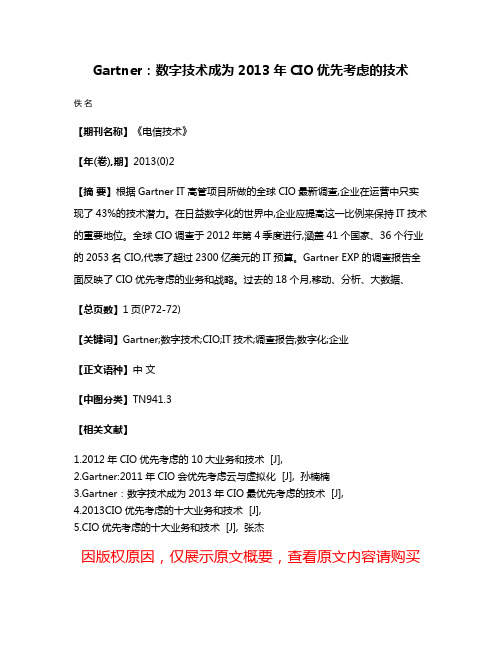
Gartner:数字技术成为2013年CIO优先考虑的技术
佚名
【期刊名称】《电信技术》
【年(卷),期】2013(0)2
【摘要】根据Gartner IT高管项目所做的全球CIO最新调查,企业在运营中只实现了43%的技术潜力。
在日益数字化的世界中,企业应提高这一比例来保持IT技术的重要地位。
全球CIO调查于2012年第4季度进行,涵盖41个国家、36个行业的2053名CIO,代表了超过2300亿美元的IT预算。
Gartner EXP的调查报告全面反映了CIO优先考虑的业务和战略。
过去的18个月,移动、分析、大数据、【总页数】1页(P72-72)
【关键词】Gartner;数字技术;CIO;IT技术;调查报告;数字化;企业
【正文语种】中文
【中图分类】TN941.3
【相关文献】
1.2012年CIO优先考虑的10大业务和技术 [J],
2.Gartner:2011年CIO会优先考虑云与虚拟化 [J], 孙楠楠
3.Gartner:数字技术成为2013年CIO最优先考虑的技术 [J],
4.2013CIO优先考虑的十大业务和技术 [J],
5.CIO优先考虑的十大业务和技术 [J], 张杰
因版权原因,仅展示原文概要,查看原文内容请购买。
- 1、下载文档前请自行甄别文档内容的完整性,平台不提供额外的编辑、内容补充、找答案等附加服务。
- 2、"仅部分预览"的文档,不可在线预览部分如存在完整性等问题,可反馈申请退款(可完整预览的文档不适用该条件!)。
- 3、如文档侵犯您的权益,请联系客服反馈,我们会尽快为您处理(人工客服工作时间:9:00-18:30)。
The Gartner Magic Quadrant is copyrighted 2009 by Gartner, Inc., and is reused with permission. The Magic Quadrant is a graphical representation of a marketplace at and for a specific time period. It depicts Gartner’s analysis of how certain vendors measure against criteria for that marketplace, as defined by Gartner. Gartner does not endorse any vendor, product or service depicted in the Magic Quadrant, and does not advise technology users to select only those vendors placed in the “Leaders” quadrant. The Magic Quadrant is intended solely as a research tool, and is not meant to be a specific guide to action. Gartner disclaims all warranties, express or implied, with respect to this research, including any warranties of merchantability or fitness for a particular purpose. This Magic Quadrant graphic was published by Gartner, Inc. as part of a larger research note and should be evaluated in the context of the entire report. The Gartner report is available upon request from .
Infoworld 2012 Technology of The Year: Heroku
Best Places to Work in IT
Leader Social Media Listening (R6) Activity Streams (Chatter) Apple App Store Rewind 2011: Chatter named Best iPhone Business App
Service Cloud: Webhost Magazine Editors Choice 2012
2010
The 100 Most Trustworthy Companies
ቤተ መጻሕፍቲ ባይዱ
TMC Excellence Award 2012:
"This Magic Quadrant graphic was published by Gartner, Inc. as part of a larger research note and should be evaluated in the context of the entire report. The Gartner report is available upon request from . To access the report, please go to ."
Positioned in the “Leaders” Quadrant
of the Magic Quadrant for CRM Customer Service Contact Centers
Magic Quadrant for CRM Customer Service Contact Centers April 12, 2012 Analyst(s): Michael Maoz
Positioned in the “Leaders” Quadrant
of the Magic Quadrant for Sales Force Automation
Magic Quadrant for Sales Force Automation July 18th, 2012 Analyst(s): Rob Desisto
Leader Platform-as-a-Service Mobile Collaboration Stevie Awards: Best New Marketing Solution 2012 Forbes: 25 fastest growing tech companies 2011
Remedy is Positioned in the “Leaders” Quadrant
of the Magic Quadrant for IT Service Desk
RemedyForce is a new strategic cloud offering from both BMC and that combines the strengths of two market leaders.
Recognition For Leadership In The Cloud
Leader CRM Customer Service Contact Centers #27 Best Places to Work in 2012
Leader Sales Force Automation
Leader Social CRM 2012 CRM Market Awards: Best Enterprise Suite CRM Best Midmarket Suite CRM
#1 Most Innovative Company in the World in 2011
2012 CRM Market Awards: Service Leader: Customer Case Management Service Leader: Web Support Barrons: World’s Most Respected CEOs 2012
Positioned in the “Leaders” Quadrant of
the Magic Quadrant for Social CRM
Magic Quadrant for Social CRM June 25th, 2011 Analyst(s): Adam Sarner, Ed Thompson, Jim Davies, Nikos Drakos, Chris Fletcher, Jeffrey Mann, Michael Maoz
The Gartner Magic Quadrant is copyrighted 2009 by Gartner, Inc., and is reused with permission. The Magic Quadrant is a graphical representation of a marketplace at and for a specific time period. It depicts Gartner’s analysis of how certain vendors measure against criteria for that marketplace, as defined by Gartner. Gartner does not endorse any vendor, product or service depicted in the Magic Quadrant, and does not advise technology users to select only those vendors placed in the “Leaders” quadrant. The Magic Quadrant is intended solely as a research tool, and is not meant to be a specific guide to action. Gartner disclaims all warranties, express or implied, with respect to this research, including any warranties of merchantability or fitness for a particular purpose. This Magic Quadrant graphic was published by Gartner, Inc. as part of a larger research note and should be evaluated in the context of the entire report. The Gartner report is available upon request from .
The Gartner Magic Quadrant is copyrighted 2009 by Gartner, Inc., and is reused with permission. The Magic Quadrant is a graphical representation of a marketplace at and for a specific time period. It depicts Gartner’s analysis of how certain vendors measure against criteria for that marketplace, as defined by Gartner. Gartner does not endorse any vendor, product or service depicted in the Magic Quadrant, and does not advise technology users to select only those vendors placed in the “Leaders” quadrant. The Magic Quadrant is intended solely as a research tool, and is not meant to be a specific guide to action. Gartner disclaims all warranties, express or implied, with respect to this research, including any warranties of merchantability or fitness for a particular purpose. This Magic Quadrant graphic was published by Gartner, Inc. as part of a larger research note and should be evaluated in the context of the entire report. The Gartner report is available upon request from .
